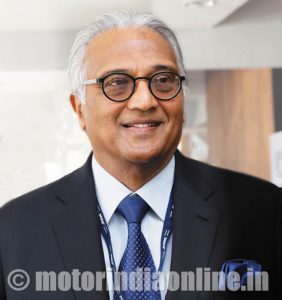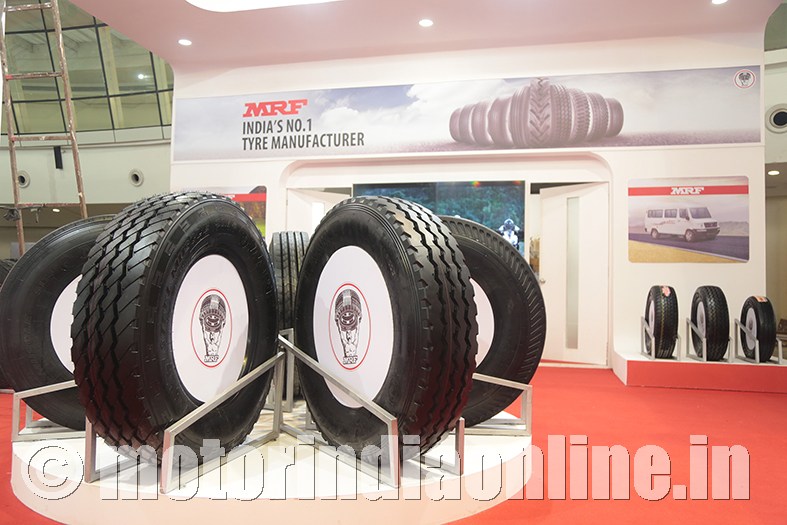R&D in progress to make tyre production more sustainable
MRF, currently ranked among the world’s top 20 tyre manufacturers, has entered its fourth decade of leadership in the Indian tyre industry. During the financial year ended March 31, 2017, the company’s total income was Rs. 15,078 crores with a net profit of Rs. 1,451 crores. Across the board there was an overall increase in all segments adding up to a 10% increase in total tyre production, with the company’s exports standing at Rs. 1,316 crores for the year.

“We have been market leaders for an unprecedented 30 years. However, competition has become stronger with tyre companies increasing their manufacturing capacities. MRF will continue to strive to be the customers’ preferred brand in the market by constantly improving product superiority, widening distribution network and ensuring brand dominance across all segments”, stated Mr. K.M. Mammen, Chairman & Managing Director, MRF.
Growth across segments
MRF clocked a sales growth of 3% over the previous year in the heavy commercial vehicle segment while truck radial sales saw a growth of nearly 11%. The company’s light commercial vehicle tyre sales increased by 11% while its passenger & SUV tyre sales showed a 5% growth. The two-wheeler segment saw MRF outpace the industry with a 12% growth in motorcycle and a very creditable 22% increase in scooter tyres. Its farm segment sales grew at a commendable 5% with the OTR segment also seeing a 9% growth.
Driven by strong growth across product segments, MRF’s overall export volumes grew by approximately 15% with agriculture, construction and truck and bus tyres leading the mix. The growth projections in export markets is expected to be around 6% to 8% over the next three years led by the increasing acceptance of Indian tyres in the overseas market. Through all this, there was buoyant demand for MRF’s commercial and passenger vehicle tyres in the Far-east and Asia Pacific.
Overall MRF’s exports turnover for the 12 months ended March 31, 2017 stood at Rs. 1,316 crores. Over the past year, the company has undertaken several initiatives to stabilize its strong markets and broaden its reach outside India. It has also planned to come out with market specific products and price-solutions to be able to reach out to the end-consumer across geographies in a more concerted fashion.
Technology absorption
New generation materials were evaluated and adapted in formulations to achieve special properties to meet the specific requirements of the customers and environmental concerns. In a step towards making the tyre production sustainable, MRF started R&D trials on using raw materials derived from environmentally sustainable sources such as biomass and waste materials. This is in partnership with a reputed Indian industry. It is also exploring the feasibility of making tyre production sustainable using nanomaterials and other smart materials.
With the broad vision of making tyre production sustainable, MRF has initiated several projects on developing low rolling resistance (RR) tyres. New process techniques have been adapted to reduce energy consumption, increase productivity and improve consistency of the process. Modernization of machinery is done to achieve higher level of accuracy and to improve productivity. Manufacturing process is being automated to reduce manual intervention and to improve quality.
Product improvements
A low RR tyre, being fuel efficient, emits less CO2 to the environment thus contributing to mitigating global warming. The company’s low RR tyres are in regular use by multinational majors. Usage of alternate and new material sources has helped in reducing the cost. Alternate materials are used to improve process efficiency. Improvements achieved in power & fuel consumption, higher machine utilization and reduction in waste loss have yielded cost reduction. Development of new design and usage of advanced materials have resulted in development of new products to meet the stringent customer requirements.
Usage of indigenous materials and process equipment might help in replacing imported materials and result in substantial cost savings. Modified process and modern machineries has helped in optimizing manpower usage in factories.
Future outlook
According to MRF, the outlook for the domestic tyre industry looks stable in the short to medium term on the back of favourable demand in both the domestic and export markets. With good monsoons and investments in the core and infrastructure segments, sectoral growth in the economy is a given and the domino effects of a 7.2% p.a. growth of GDP are likely to have many positive benefits for the tyre industry in the short to medium term. The positive sentiment shown by the infrastructure and rural sectors in recent months will definitely have an impact on the demand in the tyre industry, both in the OE and the replacement markets. A mostly normal monsoon is predicted for the new season in 2017-18, and it is believed that this will help the farm sector to show stronger performance in the coming years, with an attendant spike in rural demand that will, hopefully, help drive an all-round recovery in the next fiscal. With the exception of the HCV / MCV segment where certain doubts may remain about key factors playing themselves out fully in the new fiscal year, it is expected that fiscal 2018, will prove to be a better year for the tyre industry in volume terms, while in margin terms, the outlook remains stressed.
